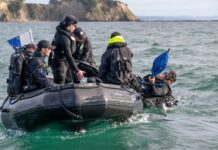Diver-assisted suction dredging will likely be employed to combat the massive spread of invasive caulerpa seaweed identified around Waiheke, according to Biosecurity New Zealand.
Addressing Tuesday’s public meeting at Old Blackpool School Hall, John Walsh, Biosecurity New Zealand’s director of readiness and response services, said existing equipment could be modified for the job.
Trials using this technique will take place shortly at Aotea/Great Barrier Island covering an area of at least one hectare to extract as much caulerpa as possible. Remaining caulerpa will be smothered using mats or hand-picked by divers.
Walsh welcomed the rāhui which Ngāti Paoa has placed on zones within one nautical mile (1.8km) of Thompsons Point and Onetangi Bay, restricting movement and activities close to the outbreak.
He said Biosecurity NZ was working with Ngāti Paoa, alongside Waiheke Marine Project, Auckland Council, the Waiheke Local Board and other groups, with talks under way to make funding available to get work underway.
“This [caulerpa] will be extremely difficult to deal with; we have it on a very significant scale,” he said.
“Ngāti Paoa is developing an action plan which we will support. If you can be as discreet and accurate as possible with suction dredging that might be the best way to handle things out there.”
Detailing the trials at Aotea, Walsh says systems being developed are looking good.
“The proof will be in the pudding in a couple of weeks. The dive assisted suction dredging that we will have at Aotea will be one operator with dive support around, in particular looking for fragmentation,” he says. • Liza Hamilton
Full story in this week’s Gulf News…. Out Now!!!







